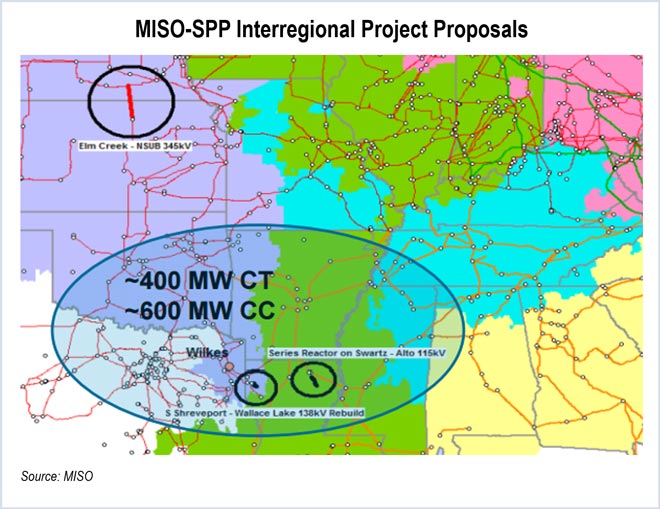By Chris O’Malley
Two of three proposed MISO-SPP interregional projects touted to offer $235 million in benefits look much less attractive following additional modeling and are likely doomed.
MISO revealed the disappointing news at last week’s Planning Advisory Committee meeting, saying the new results indicate a disconnect in coordination between the two RTOs.
MISO and SPP staff worked for several months to find economic projects to relieve congested flowgates. At one point they had identified 70 such candidates.
By June the list had been whittled down to three projects totaling $156.9 million near the RTOs’ seams in Kansas, Nebraska and Louisiana. (See 3 MISO-SPP Transmission Projects Move Forward.)
But the numbers turned out to be markedly different after the RTOs ran regional reviews that used different assumptions:
- The Elm Creek-NSUB 345-kV project that previously showed $165 million in present value benefits over 20 years fell to $29.2 million in benefits. The benefit-cost ratio decreased to 0.89 from 1.22.
- The rebuild of the S. Shreveport-Wallace Lake 138-kV line, which initially showed $46 million in benefits, is now projected at $2.7 million. The benefit-cost ratio dropped to 0.25 from 2.61.
- The series reactor on the Alto-Swartz 115-kV line showed a slight benefit decrease — to $20.7 million from $23.4 million. The project originally was estimated to have an overall benefit-cost ratio of 4.32. Based on its $4.6 million share of the cost, the benefit-cost ratio for MISO is 5.98.
“The benefit-to-cost ratio for two out of the three projects did not meet the … criteria,” said Arash Ghodsian, technical advisor for economic studies at MISO. “We were not able to see the same level of congestion that we saw in the interregional models versus the regional.”
He said the interregional and regional models differed in their generation assumptions, the impact of MISO South’s industrial renaissance load growth and their handling of MISO Transmission Expansion Planning for 2015 and out-of-cycle projects. One key factor is differing predictions on generation retirements resulting from the Environmental Protection Agency’s Mercury and Air Toxics Standards.
“Are you saying MISO applied MATS retirement assumptions about SPP generation in the MISO model, but SPP did not have the same retirement showing in their model?” asked Cynthia Crane, principal regulatory analyst at ITC Holdings.
“That’s correct,” Ghodsian said.
Crane said the inconsistencies in the modeling is a “cause for concern.”
Ghodsian agreed. “It’s part of the process differences. Moving forward, we need to do better coordination between” MISO and SPP, he said.
The fate of the projects wasn’t officially determined at the PAC meeting. They will be discussed at next month’s PAC for potential recommendation “if any,” according to Ghodsian’s slide presentation.


